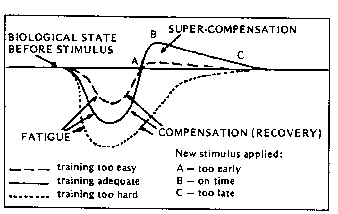|
Goals for Coaching Distance Runners
|

|
Article By: Ken Grace
Chabot College, Hayward California
Kgrace@clpccd.cc.ca.us
|
Goals for Coaching Distance Runners
1. The athlete improves
2. The athlete learns how to train
3. The athlete leaves wanting to run
4. 3% performance improvement each season
 
Three Factors Key to Distance Running
- V02 maximum - the body's ability to use oxygen at the cell level. Equivalent
to the pace that can run for 10 to 12 minutes (Balke test)
- Lactate Threshold - The speed at which lactic acid begins to accumulate in the
muscle. Lactate threshold is very low in beginning runners. Usually equivalent to pace that one can run for one
hour or 88% of V02 maximum.
- Running Efficiency
- First improvements occur as the heart size grows larger and blood volume increases.
(heart & lungs adapt first). Increases in V02 maximum.
- Later improvements that require time: the ability of the running muscles to use
oxygen at the cell level. ( adaptations that take place at the muscle cell level: more and denser mitochondria,
development of capillary beds to the muscle cell and greater number of aerobic enzymes within the active muscle
cell)
- Efficiency improves through running, changes in body composition and increases
in strength and power.
It takes 21 to 28 days for the body to adapt to a new load. Increase only between 5 to 10 % in volume each week. Drop the volume every third week.
No more then 2 Hard or Challenging Days a Week. A race counts as a hard day.
Train general to specific - Count back the number of weeks
Create 4 to 6 week cycles with a primary and secondary emphasis for each meso-cycle (3 to 6 week period) Plan Training
sessions on the duration of time spent running rather then the distance to be raced.
Need at least 20 minutes of running at a heart rate between
60 to 80% of maximum heart rate or 60 to 75% V02 maximum pace to stimulate aerobic development.
In order to stimulate the aerobic system the running portion of the interval should be between 3 to 5 minutes in
duration.

Different Training Modes:
V02 maximum intervals - 3 to 5 minutes run at, or just below, V02 maximum pace with a 3 minute recovery. Running
faster then V02 maximum pace does not bring about a faster improvement or greater adaptation.
Anaerobic Threshold Intervals - 4 to 6 minutes with 90 seconds to 1 minute recovery.
Anaerobic or Lactate Threshold Runs (AT) - 20 minutes at AT Pace (AT pace is equivalent to 88% of VO2 maximum pace.)
Generally 85 to 90% maximum heart rate.
Steady State Runs - 75 to 80% of VO maximum pace or a heart rate of 75 to 80%
Recovery Runs - run at 65 to 70% VO2 maximum or 70% maximum heart rate. Must be interspersed between Hard and Medium
Training so that adaptation can occur. Without Recovery there is no super-compensation
and adaptation.
Fartlek - Free form running changing speeds as the athlete feels the need.
Speed Training - Less then 6 seconds run at 95 to 100% effort. 20 to 60 meters. Recovery time 90 seconds to 3 minutes.
Cross Training: Pool Running, Circuit Training, Biking
The Energy Systems contribution based on Time and Effort
Anaerobic Alactic - 1 to 10 seconds (Speed Training)
Anaerobic Glycolysis at 2 minutes 50%-50%
Aerobic - at 10 minutes: 80% aerobic and 20% anaerobic. At 2 hours - 98% aerobic & anaerobic
Using Heart Rate Monitors in Training
Great for controlling pace and effort on recovery days
Indicates improves in fitness. Ability to track recovery time.
Provides feedback on stress
Excellent for fartlek and AT workouts
Not good for V02 maximum work or anaerobic lactic work.
General guidelines when using heart rate monitors: Easy aerobic training 145 to 155 bpm, Medium Training 155 bpm
to 162 bpm, Anaerobic Threshold Training 165 to 172 bpm, Recovery runs 140 to 150 bpms. All of these numbers are
general. Specific numbers must be determined with each individual athlete.
Signs of Over-training
Morning resting heart rate 10 beats higher then average
Disrupted Sleeping patterns
Rapid weight loss (more then 1 to 2 lbs per weight)
General apathy for training or anything else
General body ache - just not feeling right
Keep a daily journal on training
Record the workout. How it went. How you felt. Perceived effort. Resting heart rate and morning weight. Make sure
eat or drink something high in carbohydrates within one hour of training (This will enhance recovery and adaptation).
Drink at least 10 glasses of water daily.
Training Principles
Read:
Better Training for Distance Runners by Martin and Coe, Human Kinetics
Daniel's Running Formula by Daniels, Human Kinetics
Road to the Top by Joe Vigil, Creative Designs Inc.
Theory and Methodology of Training by Bompa, Kendall Hunt
Run with the Best by Benson and Ray, Track and Field News Press
International Copyright © of CoachesEducation.com. All Rights Reserved.
Reproduction in whole or in part in any form or medium without
express written permission
of CoachesEducation.com is strictly prohibited.
|
|
![]()




